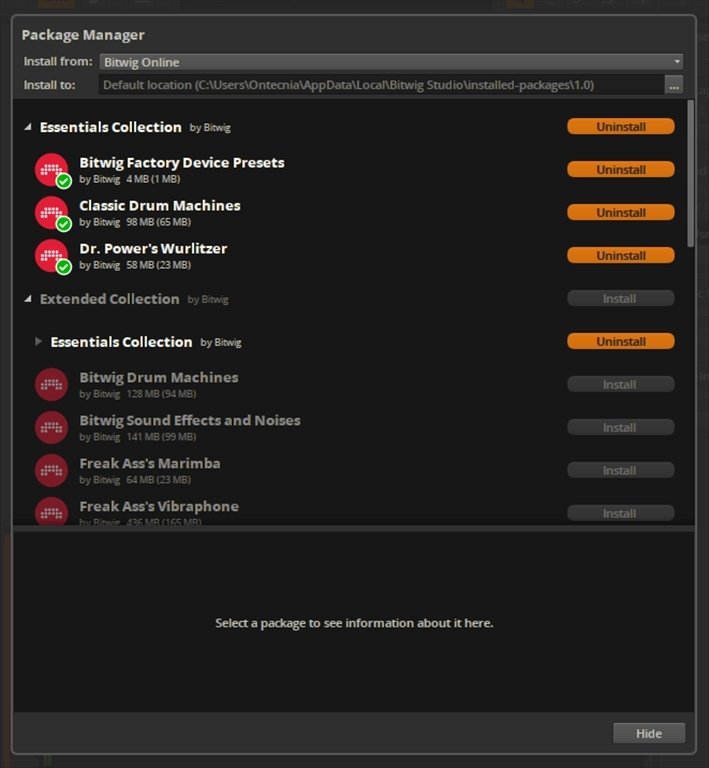
This pane can alternatively be used to display Project metadata and detail like used files and plug-ins, or a Studio I/O panel with quick access to some simple monitoring options, including mono. On the right is the searchable Browser, providing drag and drop access to all Bitwig Devices, third-party plug-ins, content libraries, and project files. To the left you’ll find a track/clip inspector containing all of the configuration and mixing options for the currently selected channel or clip. Real estate is dominated by a main central window displaying either the Arrange, Mix or Edit pages. An all-in-one screen approach provides access to most settings across four panes.

The inclusion of non-linear Clip Launching and a horizontal scrolling Device strip draw obvious comparisons with Live but the UI borrows just as heavily from other programs. On the surface, Bitwig Studio presents like most other current DAWs.
BITWIG STUDIO 2 REVIEW FULL
If you don’t believe me, you’re free to try out the full demo for yourself with only save and export functions disabled.
BITWIG STUDIO 2 REVIEW WINDOWS
Despite speculation to the contrary, Bitwig’s audio engine is not coded in Java, although the user interface is, and while the Windows installer somewhat confusingly defaults to the x86 directory you can rest assured that Studio is making full use of your 64-bit processor and memory allowances. The 64-bit application is essentially the same on all platforms and both licenses and project files will move freely between systems. You’re welcome to join in no matter what your operating system: Windows (7 or later), OS X (10.7 or later) or Linux (Ubuntu 12.04 or later). Installation and authorisation is as straight-forward as we’ve all come to expect, and mercifully dongle free. Unlike some competitors, you’re not furnished with every sound bank you could ever need but there’s certainly enough to get rolling. Similar to Native Instruments’ Service Center, this simple dialogue allows for the selective installation of a range of sample sets to your choice of location. While the current installer (we’re already up to version 1.0.8) is a fairly slender 122MB, Studio provides a healthy 4.5GB of content which can be downloaded using the Package Manager, accessible via the File menu. The relevance of this significant differential is something I’ll expand upon later.
BITWIG STUDIO 2 REVIEW DOWNLOAD
In my eyes this effectively ends any reasonable comparison with other studio workhorses and places the new kids on the block in a stoush primarily with their old bosses and a few other performance-based platforms - for now!Īt an opening download price of US$399 (A$499 for the Australian retail box) Bitwig Studio only slightly undercuts the current Live 9 Standard version ($449) but is significantly cheaper than Live Suite, which incorporates Max for Live ($749). I’m not saying you should stop reading if you’ve just spent the day tracking 24-channel live band recordings and intend to spend the next week comping, but the truth is Bitwig Studio presently includes no integrated audio take management and lacks finesse in its audio region layering and fade options. Bitwig Studio is a music creation and sound sculpting environment with a significant focus on performance workflows and a fairly heavy leaning towards sequenced genres. Which brings us to that virtual line in the sand. APPLES & ORANGESĬonsequently their newborn has been heralded as the first full-featured multitrack performance and production workstation to genuinely challenge the virtual monopoly enjoyed by Live over its sector of the market. For those of you who’ve been living in a cave lately, Bitwig Studio is the first product released by a small team of Berlin-based developers and support staff, many of whom formally served at the pleasure of Ableton. In my opinion what’s really been driving the unresolved sonic tension is our lust for a bit of good old-fashioned scandal and competition. The reality is, we’ve never had more options and depending on your musical appetite you could have turned your nose up at the meat and three veg of ProTools, Logic Pro, Cubase and Reason long ago. Considering the duration and sustained fervour of the hype, you’d have thought we’d all been wasting away on DAW rations.

Two months ago, the public release finally invited new users on board.

For anyone with their ear to the audio technology train tracks, Bitwig Studio has been generating a dull rumble for more than two years.


 0 kommentar(er)
0 kommentar(er)
